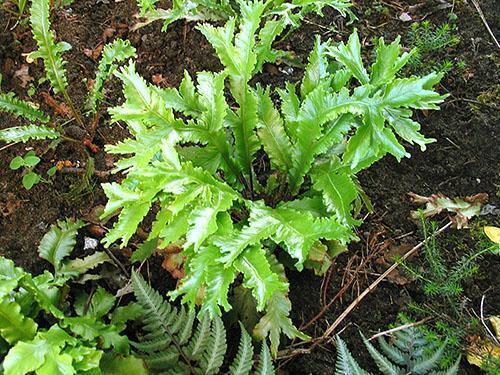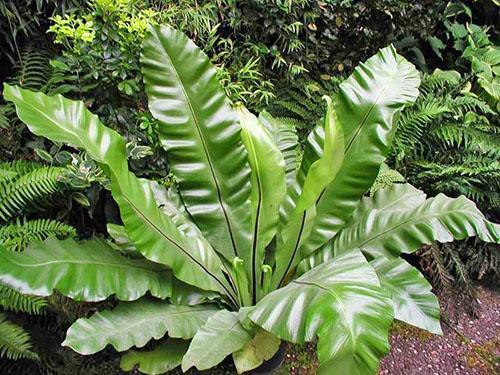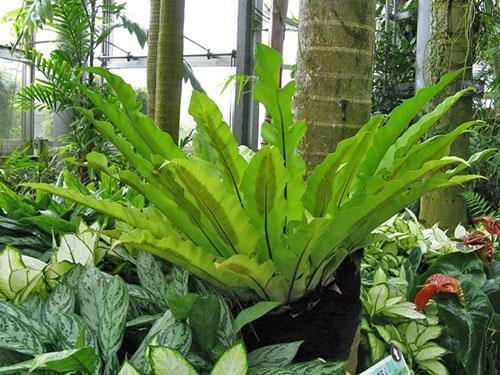Choosing an asplenium from a photo with a description
 The right to bear the generic name Asplenium has a huge number of ferns that live in different parts of the world. All Aspleniums are perennial herbaceous plants that have adapted to live not only on loose substrates, but also on trees and even stones.
The right to bear the generic name Asplenium has a huge number of ferns that live in different parts of the world. All Aspleniums are perennial herbaceous plants that have adapted to live not only on loose substrates, but also on trees and even stones.
Under such different conditions of existence ferns strikingly differ in size and appearance. Among aspeliums, there are both real giants with a rosette of meter leaves and tiny ten centimeter specimens hiding from the cold wind between stones.
Asplenium nesting (A. nidus)

In warm climates, the fern grows to considerable size, and the length of one leaf can exceed 100-120 centimeters. Unlike many other types of fern, in this case the leaves are whole, leathery or oilcloth to the touch. The color of the leaf plates is light green.
Since the plant is an epiphyte in nature, its rosette is designed so that nutrients and moisture that enter the center quickly enter the thick rhizome of the fern.
 In the photo of this species of asplenium, it is noticeable that the sporangia are located on the back of the leaves and represent convex brown-brown stripes. The central vein of the leaf is dark, rounded-convex on the reverse side.
In the photo of this species of asplenium, it is noticeable that the sporangia are located on the back of the leaves and represent convex brown-brown stripes. The central vein of the leaf is dark, rounded-convex on the reverse side.
The appearance of the fern has determined its popular name "nest". Indeed, the funnel-shaped rosette is very dense and, when the plant is attached to the trunk, very much resembles the nesting place of a huge bird.
 Despite the fact that the nesting Asplenium (Kostenets) is a native of the tropics, the fern also feels good in the apartment, however, the existing varieties are somewhat more compact than the natural form and can easily find a place on the windowsill.
Despite the fact that the nesting Asplenium (Kostenets) is a native of the tropics, the fern also feels good in the apartment, however, the existing varieties are somewhat more compact than the natural form and can easily find a place on the windowsill.
 In nature, there are two varieties of this interesting plant. Pictured asplenium nidus Plicatum with corrugated foliage. A wild specimen discovered half a century ago became the basis for breeding work and obtaining several varieties that are popular today.
In nature, there are two varieties of this interesting plant. Pictured asplenium nidus Plicatum with corrugated foliage. A wild specimen discovered half a century ago became the basis for breeding work and obtaining several varieties that are popular today.
 Another species of Asplenium, nidus Fimbriatum, is a surprisingly attractive plant with foliage scattered around the edge. And this type of asplenium, as in the photo, has also found application in indoor floriculture.
Another species of Asplenium, nidus Fimbriatum, is a surprisingly attractive plant with foliage scattered around the edge. And this type of asplenium, as in the photo, has also found application in indoor floriculture.
Asplenium viviparous (A. viviparum)
 The homeland of this unique fern species is Madagascar and other islands in the Pacific region. For lovers of indoor plants, viviparous asplenium (A. viviparum) is of interest not only in feathery bright green foliage, which forms a decorative openwork rosette, but also in the method of plant propagation.
The homeland of this unique fern species is Madagascar and other islands in the Pacific region. For lovers of indoor plants, viviparous asplenium (A. viviparum) is of interest not only in feathery bright green foliage, which forms a decorative openwork rosette, but also in the method of plant propagation.
In the tiny sporangia at the ends of the filamentous leaf lobes, spores mature, from which daughter rosettes develop right on the mother plant. Gradually forming plants fall off and take root in light, loose soil.
 Viviparous asplenium is very similar to another species using the same breeding method. This is an onion-bearing asplenium, whose description and photo are given below.
Viviparous asplenium is very similar to another species using the same breeding method. This is an onion-bearing asplenium, whose description and photo are given below.
Asplenium bulbiferous (A. bulbiferum)
 Wild specimens of the bulbous Asplenium can be seen in the rainforests of India, New Zealand and Australia.If we compare this type of asplenium and viviparous bone marrow, then here the segments of the leaves are noticeably larger, and the plant itself reaches a height of about a meter.
Wild specimens of the bulbous Asplenium can be seen in the rainforests of India, New Zealand and Australia.If we compare this type of asplenium and viviparous bone marrow, then here the segments of the leaves are noticeably larger, and the plant itself reaches a height of about a meter.
Petioles are hard, dark at the base and green at the top of the leaf. According to the photo and description of the onion-bearing asplenium, the plant has feathery, strongly dissected leaves with rounded-toothed segments of various shapes.
 The brood buds shown in the photo of asplenium are located along the edge of the leaf and give life to young ferns, creating a miniature rosette right on the mother plant. This feature of the fern allows the grower to easily get a new generation of pets. To do this, you just have to help the rosette to take root in the nutrient substrate.
The brood buds shown in the photo of asplenium are located along the edge of the leaf and give life to young ferns, creating a miniature rosette right on the mother plant. This feature of the fern allows the grower to easily get a new generation of pets. To do this, you just have to help the rosette to take root in the nutrient substrate.
 Interestingly, in the homeland of the plant, in New Zealand, this species of asplenium is called pikopiko or mauku, which means laying hen, and young leaves are used as food as a green crop.
Interestingly, in the homeland of the plant, in New Zealand, this species of asplenium is called pikopiko or mauku, which means laying hen, and young leaves are used as food as a green crop.
Both in nature and at home, plants feel better in partial shade, since the sun has a detrimental effect on feathery foliage and young asplenium plants.
Asplenium centipede (A. scolopendrium)
 It is difficult to imagine, but the centipede asplenium shown in the photo is an inhabitant of European forests. From Germany to Britain, wild specimens of this fern can be seen with whole leathery leaves up to 40 cm long.
It is difficult to imagine, but the centipede asplenium shown in the photo is an inhabitant of European forests. From Germany to Britain, wild specimens of this fern can be seen with whole leathery leaves up to 40 cm long.
In contrast to the nested asplenium, the scolopendric bone does not form such a powerful and dense rosette. In this case, the dark petioles are somewhat longer, and the almost erect young leaves begin to bend as they grow.
 While in the basic form of the plant the leaf edges are slightly wavy, in the subspecies crispum and undulatum foliage with beautiful corrugated edges can be observed. Such plants are highly valued by flower growers. Breeders have already presented lovers of decorative deciduous crops with several varieties and hybrids of the spectacular, as in the photo, scolopendra asplenium.
While in the basic form of the plant the leaf edges are slightly wavy, in the subspecies crispum and undulatum foliage with beautiful corrugated edges can be observed. Such plants are highly valued by flower growers. Breeders have already presented lovers of decorative deciduous crops with several varieties and hybrids of the spectacular, as in the photo, scolopendra asplenium.
Asplenium South Asian (A. Australasicum)
 When looking at a photo of the South Asian Asplenium, the plant can be confused with other species with whole long leaves.
When looking at a photo of the South Asian Asplenium, the plant can be confused with other species with whole long leaves.
The fern is native to the east coast of Australia and Polynesia and can inhabit the ground, under the canopy of the rainforest, and plant trunks. Moreover, the asplenium species shown in the photo is a very large plant with one and a half meter reverse lanceolate leaves. The rosette looks like a dense high rosette in the form of a funnel or bowl.
Ripening of spores takes place on the inside of the leaf plate. Sori linear, convex, located on the upper part of the leaf near the dark central vein.
Asplenium hairy (A. Trichomanes)
 At a height not exceeding 20 centimeters, the graceful hairy asplenium does not form a pronounced rosette. Fern leaves lodging, elongated pinnate. On long brown-purple petioles, as in the photo of asplenium, oval light segments are found.
At a height not exceeding 20 centimeters, the graceful hairy asplenium does not form a pronounced rosette. Fern leaves lodging, elongated pinnate. On long brown-purple petioles, as in the photo of asplenium, oval light segments are found.
In the wild, the plant prefers to settle on rocky outcrops with scarce accumulations of soil. The fern range covers some North African regions, Eurasia and the north of the American continent. The plant is winter-hardy and can be grown not only as indoor and ornamental garden culture.
Asplenium drooping (Asplenium flaccidum)
 In the forests of New Zealand, not only powerful representatives of the Asplenium genus grow, but also very unusual openwork ferns. Among them is the view shown in the photo, the drooping asplenium - an epiphyte with many times dissected long leaves up to a meter long.
In the forests of New Zealand, not only powerful representatives of the Asplenium genus grow, but also very unusual openwork ferns. Among them is the view shown in the photo, the drooping asplenium - an epiphyte with many times dissected long leaves up to a meter long.
Asplenium ebony (Asplenium platyneuron)
 A small graceful fern lives in the forest zone of North America. Asplenium, as in the photo, feels good both in partial shade and in shady places. With good endurance, common to all related species, asplenium ebony negatively refers to excess moisture. The height of an adult specimen can vary from 30 to 50 cm.
A small graceful fern lives in the forest zone of North America. Asplenium, as in the photo, feels good both in partial shade and in shady places. With good endurance, common to all related species, asplenium ebony negatively refers to excess moisture. The height of an adult specimen can vary from 30 to 50 cm.
Petioles are thin brownish-red.The leaf plates are light green, leathery. Depending on the location on the sheet, the segments range in size from 15 to 2 mm. The shape of the alternating lobes is triangular or trapezoidal.
 The rhizome is very short, requiring a small volume of soil, so asplenium, as in the photo, can be used when vertical gardening.
The rhizome is very short, requiring a small volume of soil, so asplenium, as in the photo, can be used when vertical gardening.